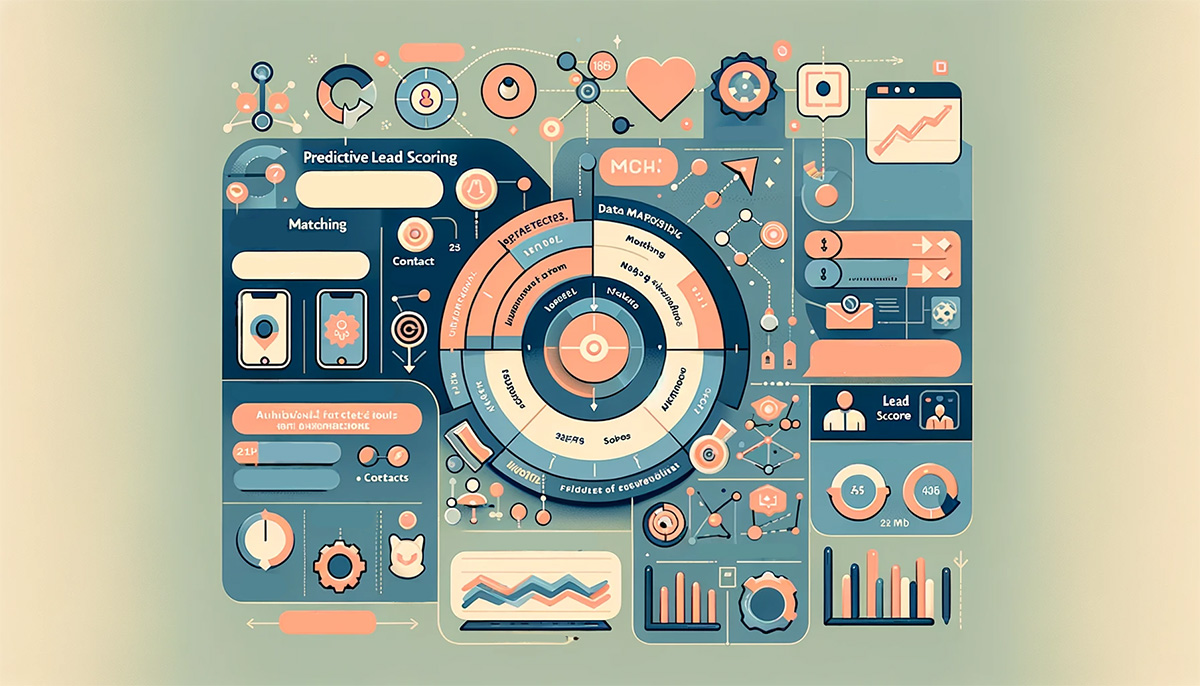Are you looking for ways to optimize your sales team’s efforts by utilizing predictive lead scoring? Predictive Lead Scoring is a process and tool for identifying leads that have the highest potential of converting into customers.
This method uses machine learning models and algorithms, to score leads based on their expected value and buying likelihood. In this blog post, we will cover five powerful tactics for using predictive lead scoring in sales so you can supercharge your business growth.
These tactics will help you create an ideal customer profile based on attributes like buyer personas, set up custom thresholds for different stages of the sales cycle, as well as optimize your current approach to better align marketing and sales teams—all while improving conversion success rates.
So what are you waiting for? Let’s explore these 5 effective tactics now!
Key Takeaways
- Predictive lead scoring is an advanced AI-driven method to accurately assess and prioritize leads based on their expected conversion probability.
- It leverages data such as website interactions, page views & past purchases in order to predict which contacts are most likely to convert into customers.
- Implementing predictive lead scoring improves sales and marketing alignment by giving them both a standardized definition of qualified leads.
- Utilizing predictive algorithms can help save time and reduce human error in analyzing large datasets for lead qualification due to its automation capabilities.
- Predictive models offer significantly enhanced accuracy rates than traditional manual systems, are adaptive and continually improve as they accumulate more data over time; allowing teams more quicker payoffs with secure long term returns from their investment into adopting the technique for predicting efficient sales outcomes.
What is Predictive Lead Scoring?

Predictive Lead Scoring is an advanced data-driven method for analyzing and categorizing leads based on a host of signals to estimate their conversion probability. It makes use of machine learning algorithms to generate dynamic lead scores that increase or decrease depending on the changing behaviors and actions performed by each contact, allowing sales teams to identify potential customers with higher precision than traditional scoring systems.
Definition and explanation
Predictive lead scoring is an AI-driven method of assessing and prioritizing contacts in order to identify those leads most likely to convert into customers. Using historical and customer activity data, a predictive lead scoring model predicts the probability that a lead will become a customer.
This score means sales teams can focus efforts on the prospects with the highest potential for success, instead of wasting time chasing bad leads. Predictive scoring solutions like 6sense use sophisticated algorithms to develop accurate scores quickly—allowing sales teams to access valuable insights faster than ever before.
Traditional lead scoring models often rely only on demographics or contact forms filled out on websites – which doesn’t always reveal crucial information about a prospect’s true buying intent.
“Predictive lead scoring uses dynamic, real-time metrics like page views, website interactions, and past purchases to predict which leads are most likely to convert into sales”
Differences from traditional lead scoring
Predictive lead scoring is a big step forward from traditional lead scoring models. It entails leveraging predictive analytics to accurately gauge the sales-readiness of prospects and dramatically boost conversions through powerful insights that focus on individual behaviors.
Unlike typical models which use static criteria such as demographics or industry data, predictive lead scoring uses dynamic, real-time metrics like page views, website interactions, and past purchases in order to predict which leads are most likely to convert into sales.
This provides more accurate results than traditional processes since it better reflects buyer behavior and interests. As a result of its increased precision, implementation time for predictive models tends to be faster and easier than legacy approaches since there’s no need for manual score re-calibration – highly optimized and targeted campaigns can be created immediately.
Utilizing AI technology also allows prediction accuracy rates to continually improve over time as the system gathers more data with each passing day so refurbished strategies become quickly available at all times.
The Benefits of Predictive Lead Scoring

Predictive lead scoring can help improve sales and marketing alignment by allowing the sales team to focus on higher-value leads, while providing valuable intelligence that enables marketers to increase their lead generation strategy success rate.
Additionally, utilizing predictive algorithms helps save time and reduce human error in analyzing large quantities of data.
Improving sales and marketing alignment
Predictive lead scoring offers an effective way to improve the working relationship between sales and marketing teams. By offering both departments a standardized, unbiased definition of qualified leads, predictive lead scoring can provide better alignment between the two teams.
Not only that, but it also enables more efficiency and accuracy when it comes to qualifying leads. This in turn helps generate a better understanding of potential prospects based on their behaviors: this could include which channels they’ve interacted with or what level they are at within the sales funnel.
With predictive lead scoring providing these insights analytic data easily available for both teams, companies can benefit from dramatically improved collaborative effectiveness while making sure each team is focussing its efforts on those prospects who will bring returns leading to even greater success for any business.
Saving time and reducing human error
Predictive lead scoring gives sales teams the advantage of efficiency and accuracy. This modern approach to analyzing and responding to leads uses automation along with data-driven insights to identify high quality opportunities quickly, reducing the amount of time sales reps must spend wading through massive amounts of unqualified leads.
To make sure that every lead is given accurate consideration, predictive lead scoring applies machine learning algorithms which eliminate human bias or error associated with traditional manual processes.
“Nearly 47% of marketers have reported an immediate improvement in the quality of leads with predictive lead scoring, with 98% of organizations committing to reusing it for their businesses”
Automating mundane tasks like prospect segmentation further aids in streamlining the sales process – freeing up team members so that they can focus on building relationships instead of laboriously reviewing every single inquiry by hand.
Additionally, predictive models are adaptive and learn from their environment; as a result, scores for each opportunity continually evolve over time based accurate reflections of its potential contribution.
Faster results and continual improvement
Predictive lead scoring is fast becoming a standard of the sales game, offering unprecedented capabilities to cut through data overload en route to faster results. Setting up and calibrating predictive lead scoring happens quickly than traditional methods, meaning sales teams can start to leverage insights faster.
Additionally, predictive models are constantly learning and improving over time—meaning they become smarter with every interaction and offer continual improvement in predicting future leads and unlocking additional opportunities for growth.
By contrasted with manual or static approaches that may yield diminishing returns after initial implementation; the feedback loop involved in predictive models ensures improved response rates to marketing tactics while continually optimizing scoring criteria based on real-time customer interactions.
Tactics for Using Predictive Lead Scoring

The right tactics for employing predictive lead scoring can be instrumental in leveraging the potential advantages, such as increased accuracy and efficiency. Dive into four essential steps to make sure you’re optimizing your scoring process.
Create an ideal customer profile
When using predictive lead scoring, creating an ideal customer profile (ICP) is central. This ICP should be crafted based on historical data and past purchasing behavior that identifies key characteristics of the most successful customers.
“Sales teams who prioritize sales efforts and create lead scores achieve revenue plans 18% more often and meet or beat their quotas 22% more often”
Use real-time scoring
Real-time scoring is one of the most effective ways to utilize predictive lead scoring for sales teams. By incorporating real-time scoring, leads are able to be scored based on their current behaviors and interactions – this allows sales teams to prioritize which leads should receive an immediate response, increasing the likelihood of successful conversion.
Additionally, with real-time scoring in place, sales teams can get accurate insights into what actions need to be taken right away in order to best engage prospects and nurture them along the buyer’s journey.
Real-time scoring also enables sales teams adapt quickly by updating lead scores in real time based off of customer data points or events that occur during outreach. This gives sales representatives greater agility when responding & more efficient processes leading up to conversions; allowing organizations a higher speed and accuracy rate when it comes closing deals!
Utilize views and lead scoring widgets
Lead scoring widgets are an incredibly effective tool for sales teams to focus their time and effort on the best potential leads. Predictive lead scoring assigns a score to each prospect based on behavior, engagement and attributes, allowing sales teams to prioritize leads with higher scores.
Instead of wasting resources chasing people who may never convert into customers or making mistakes assigning too low priority to someone who was really interested in your product yields better qualified leads in less time, saving both energy and money.
Configuring predictive lead scoring allows companies to set up criteria that is tailored according to their ideal customer profile; with variables such as location, profession, interests and behaviour tracked over time improving precision and accuracy further.
The widget can identify emerging leads early in the buying cycle: for example when they view certain web pages multiple times or download whitepapers without registering at all. Integrating data from disparate sources also gives insights that were unavailable before (how many emails were opened?, which campaigns performed well? etc.).
This real-time data lets businesses figure out where prospects are in their journey so they can tailor communication accordingly resulting in streamlined operations and faster conversions in comparison with manual processing techniques like traditional lead scoring.
Implementing Predictive Lead Scoring in Your Business

Learn how to maximize the return on your lead scoring system investment and drive better sales outcomes by leveraging 6sense’s capabilities.
Understanding license and role requirements
When integrating predictive lead scoring into your business, it is essential to first have a comprehensive understanding of the underlying license and role requirements. Depending on the particular technology being employed, certain licenses or designated roles may be needed for successful deployment.
To make sure that any predictive lead scoring software is being used correctly and effectively, businesses must ensure they have access to the right licensing and roles ready at hand prior to implementation.
For instance, some tools might require an online application specialist who will need both technical qualifications as well as experience in sales or marketing operations depending on how the tool is implemented within the organization.
Similarly, particular licensing agreements per vendor should also be reviewed beforehand to ensure proper utilization of said technologies while staying compliant with company policies and government regulations.
Conclusion.
Predictive lead scoring can provide sales teams with powerful insights into potential customers and enable high-level business strategies to be implemented. Predictive lead scoring not only increases efficiency by reducing manual tasks, but also rapidly improves results as data is continually analyzed for better insights.
This system provides a standardized approach that leads to higher conversion rates, improved alignment between sales and marketing efforts, and more efficient targeting of leads with the highest potential value.
With all these advantages, predictive lead scoring should be considered an essential component of any successful team’s strategy in today’s competitive environment.
FAQs
1. What is lead scoring?
Lead scoring is a method used to identify the quality of potential customers and prioritize them based on their predicted sales readiness.
2. How can predictive lead scoring improve my sales process?
Lead scoring helps businesses align sales and marketing strategies by setting thresholds for which leads are deemed valuable, optimizes your lead conversion rate, and focuses on pursuing the best qualified leads first.
3. What are some best practices for lead scoring?
Some of the most successful lead scoring best practices involve creating distinct lead scores based on data points or attributes that track how each individual contact interacts with your marketing or sales content over time. Mobile matching, positive versus negative score metrics, automated warning signs for suspicious activities are other important considerations in establishing an effective system of score measurement when implementing predictive Lead Scoring processes.
4. How do I calculate a basic Lead Score?
The basic formula involves calculating both total weighted point values attributed to discrete behaviors (attitude & intent) as well as assigning minimum/maximum weights towards unique prospects’ demographics such as number of employees household income etc… One should assign higher point values to more desirable criteria like website visits or inquiries, while lower value-points may be assigned to less responsive interactions like clicking emails etc…
Depending on organizational structure one could further customize different categories: Sales teams may require longer duration until a prospect funnel matures before becoming eligible for “sales ready” status; whereas Marketing department could use shorter spans with more contents sharing parameters taken into account when some automation implementation adds tolerance against certain target prospects variant conditions (industry sector specific).
If you like this post check out other AI-related articles:
How Can AI Tools Be Used For Sentiment Analysis In Marketing?
How can AI tools improve your overall marketing strategy


